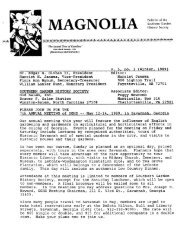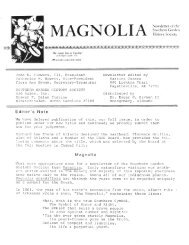Vol. XII, no. 2, 3 & 4 - Southern Garden History Society
Vol. XII, no. 2, 3 & 4 - Southern Garden History Society
Vol. XII, no. 2, 3 & 4 - Southern Garden History Society
Create successful ePaper yourself
Turn your PDF publications into a flip-book with our unique Google optimized e-Paper software.
<strong>Southern</strong> <strong>Garden</strong>s of the<br />
1850s . . . continued from page 8<br />
the taking up all of the roots that can be saved ,<br />
and especially the small fibrous ones; covering the m<br />
with wet moss or gunny bags, or old carpets, etc ., to<br />
keep them from being dried by the air or sun. When<br />
the tree is a handsome or valuable one, it should b e<br />
lifted with a sufficient mass of earth to insure its safety .<br />
Trees or shrubs which have been prepared the yea r<br />
before for removal, as is done in all the good nurseries ,<br />
can be transplanted with infinitely less risk than thos e<br />
from the fields or woods . I have large specimens of<br />
English Laurel, Euonymus, Cedars, Junipers, Spruces ,<br />
Japan Plums, Hollys (sic), Mag<strong>no</strong>lias, etc., which have<br />
been repeatedly root-pruned, so that a very moderat e<br />
sized ball of earth would contain all of the root s<br />
necessary to the well-being of the plant .<br />
Transplanting should be done, <strong>no</strong>w, as early a s<br />
possible . November, February, and March, I deem th e<br />
best seasons here. Plant <strong>no</strong> deeper than the tree grew<br />
naturally. Mix the manure with the best of th e<br />
soil that came out of the hole ; when the manure<br />
is rank and coarse, best put in the larger portio n<br />
near the surface . Finish with a few buckets of<br />
water, and stake the tree or plant firmly, that it may <strong>no</strong>t<br />
be shaken with the wind .<br />
In removing large trees, thin out the top somewhat ,<br />
and shorten the branches : but never trim the tree to a<br />
hare pole, or anything approaching to it . For although<br />
in some instances trees thus treated may live, they wil l<br />
he exceptions to the rule. In transplanting Live oaks, I<br />
prefer clipping off a portion of the leaves, first<br />
shortening the branches . I have a very handsome lot of<br />
these, <strong>no</strong>w five to six feet high, which have been twice<br />
transplanted and root-pruned, so that they may <strong>no</strong>w h e<br />
removed with entire safety .<br />
In conclusion, let me advise those who have place s<br />
to improve, to secure good sized plants, if such can be<br />
had that can safely transplanted . A pleasing effect i s<br />
thus produced, and at once, which would otherwis e<br />
require long years of waiting for . +<br />
Foot<strong>no</strong>tes :<br />
Hortus III recognizes the Holly oak as Quercus Ilex, a native of th e<br />
Mediterranean region . The exact identity of this plant is <strong>no</strong>t certain . There are<br />
several oaks that have a holly-leaved form . . .<br />
2 The Turkey oak is <strong>no</strong>w k<strong>no</strong>w as Quercus laevis . Hortus Ill recognizes<br />
<strong>no</strong> forms of "turkey oak, as the cut-leaved one he refers to .<br />
3 Sterculia platanifolia was reassigned and is <strong>no</strong>w Firmiana simplex.<br />
a The identity of this plant is <strong>no</strong>t certain . Erotica has a listing for a tree<br />
croton . Codiaeum poilanii, but this is <strong>no</strong> guarantee they are the same plant.<br />
'The identity of this plant is <strong>no</strong>t certain .<br />
6 Acacia julibrissin was reassigned and is <strong>no</strong>t Albizzia julibrissin .<br />
The Spanish chestnut is a<strong>no</strong>ther name for the European chestnut ,<br />
Castanea pulchella .<br />
8 Salix babylonica 'Crispa' or sometimes called 'Annularis', introduce d<br />
1 730 (Dirr) . The more commonly seen Salix matsudana 'Tortuosa' was <strong>no</strong> t<br />
introduced until 1923 (Dirr) .<br />
Salisburia adiantifolia has been reassigned and is <strong>no</strong>w Ginkgo biloba.<br />
10 This sentence can be read as one plant with two different commo n<br />
names . or two separate plants . Longleaf pine is Pinus palustris . The identity o f<br />
the second one is uncertain. L.H . Batley identifies the Old Field Pine as Pinus<br />
taeda . the Loblolly pine .<br />
11 The Norway spruce is <strong>no</strong>t Abies, but Picea abies. This group wa s<br />
pulled out of the Aibes group, which are the Firs, and put in a genus all thei r<br />
own .<br />
12 This plant, Juniperus suecica, is <strong>no</strong>w thought to he a form of Common<br />
juniper, J. Communis var . fastigiata.<br />
13 Today, V. lucidum, meaning "the shinny viburnum ." is <strong>no</strong> longe r<br />
recognized . It was the old name for a Viburnum tinus cultivar, according t o<br />
Hortus III . It should be written V. tinus var. 'lucidu m<br />
14 This plant name should he written Viburnum tinus . according to Hortus III .<br />
15 This quote by the famous landscape architect practicing at the time u p<br />
North- and widely read in the South- appears <strong>no</strong>t to be complete as written .<br />
Apparently the last word was left out during typesetting . It should probably rea d<br />
"on our Republican soil ."<br />
16 The exact identity of these three forms of Laurel is <strong>no</strong>t certain . Hortu s<br />
III recognizes three forms : one with very narrow, willow-like leaves, one wit h<br />
golden leaves, and one with leaves that have a wavy margin .<br />
17 Now Photinia glabra, Japanese photinia .<br />
18 This plant appears to be what is <strong>no</strong>w Ligustrum lucidum, the Waxlea f<br />
ligustrum, which is evergreen in Alabama . Further <strong>no</strong>rth the extreme cold wil l<br />
cause it to loose all its leaves. Hortus 111 says that the real Chinese Privet, L<br />
sinense is deciduous.<br />
19 The identity of these three forms is uncertain .<br />
20 Eriobotrya japonica, the Loquat.<br />
21 The exact identity is <strong>no</strong>t k<strong>no</strong>wn . Because he calls it a Fringe tree, it ca n<br />
he Chionanthus virginicus, Grancy greybeard, hut you could <strong>no</strong>t describe th e<br />
flowers as hazy spikes . This description could apply to the lilac-chaste tree ,<br />
Vitex agnus-castus<br />
.<br />
22 Philadelphus . The native is P. i<strong>no</strong>dorus and has <strong>no</strong> fragrance .<br />
P . coronarius, which looks very much like the native, is strongly scented .<br />
23 Probably the Scotch broom, Cytisus scoparius .<br />
Of<br />
Note<br />
Historic Landscapes Institute:<br />
Peserving Jefferson's Landscape and <strong>Garden</strong> s<br />
For two weeks in June, the gardens and grounds of Monticello and the University o f<br />
Virginia will serve as the setting for a unique educational experience in the theory and practic e<br />
of historic landscape preservation. This newly created summer institute is designed as an<br />
introduction to landscape history, garden restoration, and historical horticulture by using th e<br />
landscapes of Monticello and the University as case studies and outdoor classrooms. Monticello<br />
staff and UVa faculty will provide instruction through lectures, walking tours, field trips, and<br />
field work. The 1997 Institute will be held from June 15th-27th . For more information, contact<br />
Charlottesville Regional Programs, UVa, (804) 982-5313 or fax (804) 982-5324 . +<br />
9
















